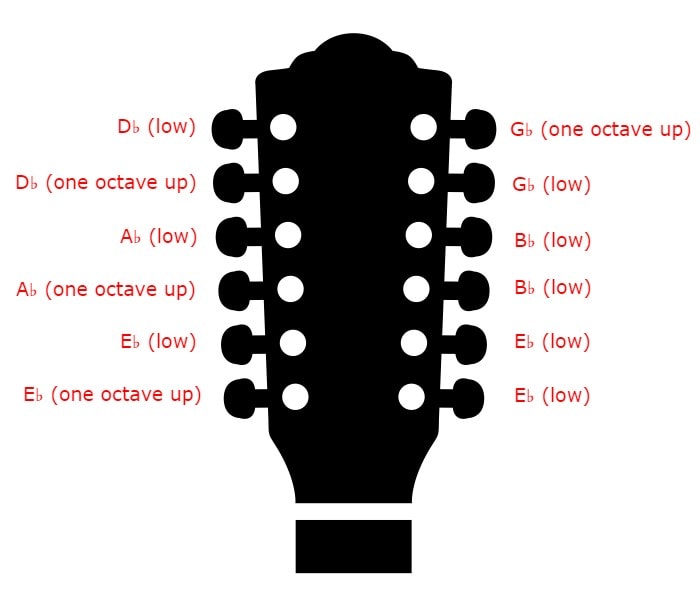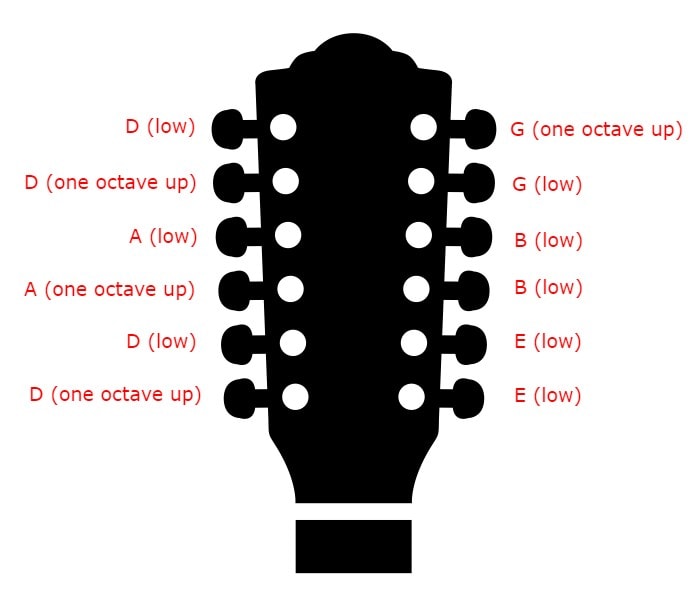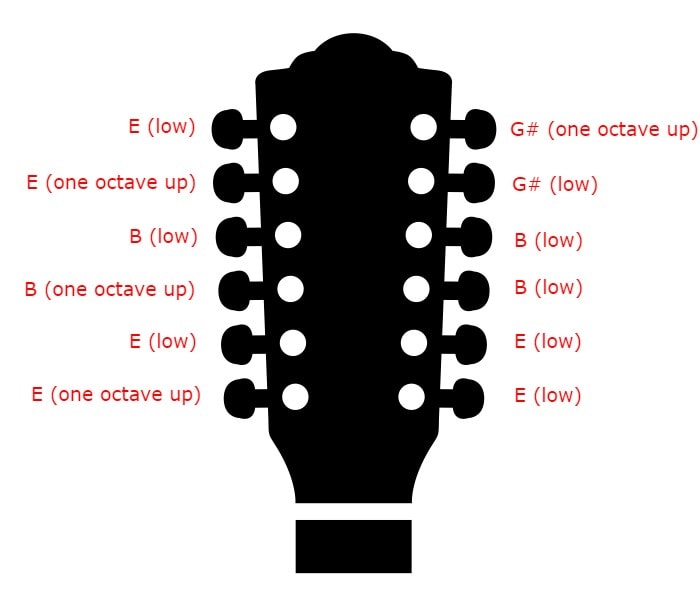Whether you’ve already taken the plunge and bought one, or you’re still thinking about whether it’s right for you (check out our favorites under $1k here), the 12 string guitar, at least on the surface, appears to bring a new set of challenges, one of the most obvious being tuning.
Fortunately, keeping a 12 string at pitch is no more difficult than a standard 6 string! In this KillerGuitarRigs guide, we’ll be teaching you everything you need to know about tuning 12 string guitars, including:
- What is the standard layout of a 12 string guitar?
- Can you use regular guitar tuners for 12 string guitars?
- Which order should I tune a 12 string guitar?
- What is “Nashville Tuning”?
- Is it possible to set up a 12 string with drop tuning and other alternative tunings?
Contents
- What is the Standard Layout of a 12 String Guitar?
- Can you Use Regular Guitar Tuners For 12 String Guitars?
- Which Order Should I Tune a 12 String Guitar?
- What is Nashville Tuning
- Is it Possible to Set up a 12 String With Drop Tuning and Other Alternative Tunings?
- Final Thoughts on Tuning a 12 String Guitar
What is the Standard Layout of a 12 String Guitar?
Believe it or not, 12 string guitars in the standard layout are tuned to the same notes (with a little variation in octave) as a standard 6 string. This is why learning to play a 12 string really isn’t all that difficult, despite the intimidation factor of having double the strings.
To make life easier when tuning your 12 string, think of it as having 6 pairs (known as courses) of strings rather than 12 individual strings. When looking at how the strings are laid out, you can clearly see that they are not evenly spaced, but rather, set up with a gap in between each pair.
The layout should be familiar to anybody who plays a regular 6 string, as the pattern is still based on EADGBE. The difference is that the low E, A, D, and G strings have a paired string that is tuned one octave higher, with a smaller gauge. The B and high E are paired with strings tuned to the same pitch and octave (plus both strings in each pair are also the same gauge).
So, to bring your 12 string to standard pitch, you would have the strings tuned as follows:

This arrangement is the reason for the jangly, sparkly sound that 12 string guitars are famous for. The lower four pairs all play in harmony, which leads to a chorus effect. Because the pairs are different gauges and struck slightly apart, they end up vibrating out of phase with each other, and it’s this phenomenon that creates such a pleasing sound.
As you can see, it’s really not as difficult as it seems at first glance.
Can you Use Regular Guitar Tuners For 12 String Guitars?
The quick answer to this question is yes, however, there are some stipulations. First of all, a regular non-chromatic tuner will not work effectively. These tuners are only programmed to recognize standard guitar tuning at the standard octave, so even if your +1 octave low E string was at the correct pitch, a non-chromatic tuner would tell you it was too sharp.
On the other hand, a chromatic tuner is programmed to recognize any note you play. This is essential, because as we know, 4 of the strings on the guitar are tuned +1 octave in standard tuning, and with some alternative tunings there are even more variances.
Chromatic tuners are available as clip on tuners, plug in tuners, or even pedal tuners (check out our recent post on the differences between the Boss TU2 vs TU3 for more info on pedal tuners!)
If you find yourself without a tuner, whether yours is lost, broken, or otherwise unavailable, you’ll be pleased to know that there’s a good chance you carry a potential tuner around with you all day every day – your smartphone.
There are guitar tuner apps available to download for free (although some do come at a charge) that will help you get your 12 string tuned in a pinch. Some act as standard chromatic tuners, while some are designed specifically to tune a 12 string. The beauty of these apps is that they can also be used to tune 12 strings to some of the alternative tunings we’ll cover later on.
Some of the more highly recommended apps include the Fender Tune app, GuitarTuna, and iStroboSoft.
If you don’t happen to have a smart phone, or you’d just rather not use one, it’s still possible to simply tune by ear. There are a lot of videos online that will simply play though the strings on a 12 string guitar one by one. All you need to do is adjust the pitch of each string until it matches what you hear in the video. You can do this using your computer, phone, or any other device capable of connecting to streaming sites like YouTube.
Which Order Should I Tune a 12 String Guitar?
The next question is, in which order should you actually tune a 12 string guitar? Like with any other guitar, there is always the chance of breaking strings while adding tension, but with a 12 string the risk increases due to the narrow gauge of the additional strings.
By following this order, you’ll ensure that the initial tension is being taken up by the thickest strings, and therefore reduce the potential for breaks.
Start with the strings that match regular 6 string gauge and tuning and tune them just as you would with a standard guitar. Begin with the low E, bring it to pitch, and work through the A, D, G, B, and E. With the B and high E strings, tune the string on the right hand side of the course. If you’re a lefty, this would be opposite, and you’d tune the B and high E on the left side of the course.
Because 12 string guitars are under significantly more tension than 6 strings, it’s very important to go back over the strings you’ve tuned and touch up before moving on to the next step.
Once your standard size E A D G B E strings are at pitch, it’s time to tune the second strings in each course.
Keep a close eye on your tuner as you add tension to the + octave strings. This is particularly important with the + octave G string as it’s the thinnest on the guitar and is most prone to breakage. Once the four + octave strings are at pitch, move on to the secondary B and E strings.
With the added tension of the second course of strings, it’s inevitable that the strings you’ve already tuned will drop and register flat, so, it’s important that you once again revisit each string and retune. This time, you will need to tune each string in order – eE aA dD gG BB EE.
What is Nashville Tuning
You may have heard of something called Nashville Tuning, which is a 12 string technique that requires 2 six string guitars. If you’re trying to emulate a 12 string sound, but you don’t have access to the right guitar, Nashville tuning can help.
For this technique, you and a friend would each need a standard guitar, and a packet of strings designed for a 12 string. One guitar should be strung with the + octave strings of the 12 string set (plus the B and high E). The other guitar will be strung with the standard pitch E A D G B E setup for a regular 6 string.
If playing live, both guitars would be played in unison to achieve a similar effect to a 12 string. To many, Nashville tuning sounds even better, as the strings are further out of phase when played this way, leading to a much more ear pleasing chorus effect.
In the studio, this technique can be achieved with a single guitar and double tracked. Of course, this would mean stringing with one set, recording, then restringing with the other course. It takes some work, but the results are usually excellent. The most notable examples of this are Wild Horses by the Rolling Stones, and Dust in the Wind by Kansas.
Is it Possible to Set up a 12 String With Drop Tuning and Other Alternative Tunings?
Once you’ve mastered the basics of standard tuning on your 12 string, you might want to start experimenting with some alternative and drop tunings. Not only do they present a new challenge, but they also unlock a whole host of different songs and styles of music for you to play.
Drop tunings have even more benefits with 12 strings. Consider this – the + octave strings are rather fragile. If you’re a heavy strummer, or you’re trying to play loudly, those strings are living on borrowed time. By tuning down, you’re significantly reducing the tension on the strings, and by reducing the tension, you’re reducing the chances that they’ll break prematurely during a spirited riff.
Additionally, reduced tension can help to relieve one of the other big drawbacks of playing a 12 string – finger discomfort. Again, because standard tuning holds so much tension in the strings, and because there is more skin to string contact, new players will often end up with painful fingertips while they wait for calluses to develop.
When you drop tune, the force required to depress the strings is reduced, making the instrument overall much more comfortable to play. Of course, when an instrument is comfortable to play, you’re way more likely to pick it up, and if you pick it up more, you’ll progress much faster.
Older 12 string guitars were often tuned down to prevent damage to the necks. This isn’t too much of an issue on modern instruments since truss rods handle the bulk of neck tension, but if you’re playing a vintage guitar this is definitely something to think about.
Semitone Drop
One of the simplest alternative tunings to set up is a full semitone drop. This means dropping every string by a semitone. This is why having a chromatic tuner is so important, as it will indicate when each string is reading a semitone flat or sharp.
When you tune down one semitone, the strings should be tuned as follows:

Drop D
Just as a 12 string plays almost identically to a standard 6 string, you can also apply the same drop tunings to them as well. While most drop tuning is typically done on electric guitars and used for metal, there may well be times in which you need to drop your 12 string to drop D.
When tuning to drop D, the strings should be tuned as follows:

Another popular alternative to standard tuning is open tuning. When a 12 string guitar is tuned this way, it will play a major or minor chord without any strings being fretted. Open tunings are incredibly useful for certain music styles, particularly slide guitar.
Some popular open tuning arrangements for 12 strings include:
Open G

Open E

Open C

Open D

Remember, the two highest courses, no matter the tuning, are always tuned in unison!
If you are interested in open tunings, we also have articles about six string tunings for open E, open G and open D, as well as a whole article on other alternative tunings.
Final Thoughts on Tuning a 12 String Guitar
It’s important to reiterate that tuning a 12 string guitar is actually no more difficult than tuning a six string, yes there are more strings to deal with, but the similarities in string layout makes it a breeze. Remember, a good quality tuner will always help, and take your time – especially when tuning the + octave strings, to prevent breakages.


